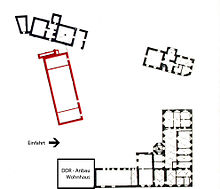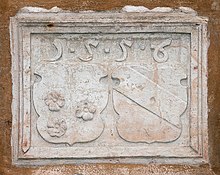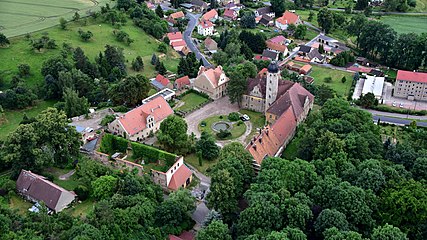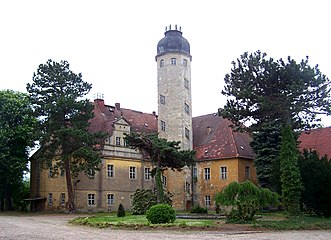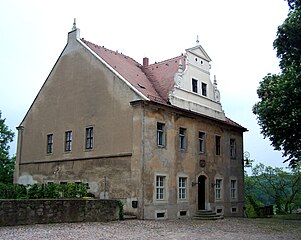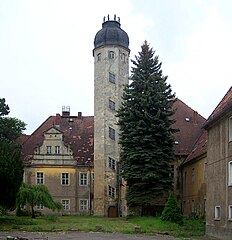Schieritz Castle
Schieritz Castle is a Renaissance castle in Schieritz in the Ketzerbachtal , six kilometers east of Lommatzsch and seven kilometers northwest of Meißen in the Free State of Saxony .
Name interpretation
The place name is generally traced back to a Sorbian field name and is of Old Slavic origin (around 6th / 7th centuries). It means width . Because of the sound shifts that may have occurred over time, Schieritz can also mean apron or apron . An apron prevented injuries when working as a stonemason or miner. In a figurative sense, the gentlemen were thus on Schieritz by its castle like an apron protected to prevent damage ward.
location
The valley of the Ketzerbach , which widens towards the Elbe, leads this into the Elbe at Zehren . Up until 1945 there was a vineyard on the Eckhardsberg , which borders the site . In Kirschberg are kaolins . Schieritz is only one kilometer away from Zehren, which is the same age. In 1003 Bolesław Chrobry Wielki Glomuci destroyed the central sanctuary of the Wends who lived here .
Building description
lock
The castle has a striking hipped roof towering over the Ketzerbachtal , which has been extended with dwelling houses with renaissance gables protruding. The main part, the former manor house, consists of a basement and two upper floors. The square sandstone construction of the tower portal dates from the construction period around 1555. The farm building, which was built in the second half of the 19th century, has cross-vaulted ceilings . The brandy distillery was housed in the directly adjacent south wing , or there is a column, as well as two further columns in the Tuscan order in the former kitchen . The base plate is octagonal and has a transition to the 67 cm thick barrel-shaped shaft, a weak bulge and slightly protruding plate on which the vault rests directly. The arched access door from the courtyard bears the coat of arms of von Schleinitz and Sundthausen and the year 1556 in the garment as a keystone . The chapel of the castle was on the second floor of the south wing. The south-eastern part was the former administrator's apartment and dates from the 16th century. The 42.6 m high tower was reconstructed in 1882 and 1919. In the 1970s the lantern became dilapidated and was badly damaged in a storm on December 31, 1977. In 1987 it had to be secured with the help of mountaineers, but in 1993 it had to be completely dismantled. The window frames are without the profiles typical of the Renaissance and possibly come from a window enlargement from the 17th century. The display gables, which can be seen from afar, are possibly also a work of the historicizing zeitgeist and date from the 19th century. At the north-western entrance there were sandstone posts for the gate, on which the royal Saxon coat of arms and a monogram P.GHS was, as a reference to Prince Georg, Duke of Saxony, who was the owner of the castle between 1862 and 1869.
Schieritz economic estate
Behind the towering castle lies the farm property, which can be reached via a gently rising ridge. Eight villages, Kaisitz , Kleinkagen , Obermuschütz , Seylitz, Zscheylitz, Zehren mit Keilbusch , Ickowitz and part of Klappendorf were under the jurisdiction of the old script and belonged to the Meißen office . The manor was patronized by church and parish officials and the school in the village of Zehren and awarded six scholarships to the Meißner state school St. Afra . On April 1, 1923, the 153 hectare manor Schieritz was merged with the community of Schieritz. The large barn in the north-east of the courtyard, the rear of which was accessible via a bridge, was built in 1600 and expanded in the 19th century, but destroyed in a major fire in 1971.
Castle mill
The mill location is already marked in the Ur-Oeder (1589–1602), but it is probably much older. Originally the mill was built as a wood and cutting mill, later mainly used as a grain mill and to generate electricity for Schieritz Castle and the community as a water power plant. From 1905 to 1917 the built-in spiral turbine provided 5 kW of electrical power for the entire village, manor, brewery, blacksmith shop and inn. The mill wheel with a diameter of 3.9 m and a width of 2.25 m is driven by the Ketzerbach .
history
Tower hill castle Dragonerberg
The medieval tower hill castle Schieritz with section wall, as well as the outer bailey and associated section wall, the whole includes a throat ditch, is not identical in place and location with the possible predecessor building of the Schieritz castle and also unsecured in the period from 1200 to 1250 currently classified by experts, only for the reason that the existing and assignable documents speak only from 1260. What is certain is that the use of the tower hill castle ended at the beginning of the 13th century.
Predecessor of the Dominus Conradus
In 1902, during paving work on the altar of the Seusslitz church, a sandstone slab was found with the image of a knight who was still wearing the Roman garb of the 13th century and in his left hand an unsplit shield with three five-petalled roses. This coat of arms was identical to the form of the Schleinitz coat of arms, which is preserved on a document Peter von Schleinitz dated December 12, 1350, through which he sold money and grain interest in Altlommatzsch to the Clariss monastery in Seusslitz . According to this, Dominus Conradus, buried there in September 1288 at the holiest place of the monastery confirmed by the Pope in 1255 (the rest of the stone was broken off) is a de Slinicz . Schieritz is a place with a very old history and was one of the numerous border fortresses on the Elbe. Otto Eduard Schmidt therefore hypothesized as early as 1906 that Konrad von Schleinitz zu Seusslitz in the easternmost part of the Lommatzscher care must have had a similar relationship to the Clariss Monastery of Seusslitz as his relatives in the westernmost part to the St. Afra Monastery in Meißen . Konrad von Schleinitz was possibly enfeoffed with the Burgward Zehren mentioned in 1003, but its military use as Burgward ended at the beginning of the 13th century. A possible relationship between Dominus Conradus de Slinicz and a previous building (the successor to the Dragonerberg fortification) on the militarily more important route through the valley from the rough Fuhrt to Lommatzsch , the current location of Schieritz Castle, is logical, but not documented or archaeologically secure.
From Gorenzk (1349-1361)
In 1360 Ulrich von Gorenzk is mentioned as the manor owner as dicti de Schyricz and his wife Agnes with their five sons.
von Schleinitz (1416–1441)
In 1416 a knight Hannes von Slinicz zu Schiricz is mentioned.
Rosenhain (1411-1457)
The von Rosenhain (also von Rosenberg) came from Upper Lusatia.
From Miltitz (1457–1460)
In 1476 Georg von Miltitz made a pilgrimage to Jerusalem with Duke Albrecht and Heinrich von Starschedel .
Von Rechenberg (1460–1490)
In 1460 the Lords of Rechenberg resided here.
From Sahlhausen (1409–1513)
In 1480 a Friedrich von Sahlhausen is mentioned as the owner († 1480 Meißen). His son was John VI. from Saalhausen .
By Arras (1513–1549)
Dittrich von Arras came from Thuringia .
Von Schleinitz (1549–1841)
The von Schleinitz family is a Saxon nobility and was first mentioned in a document in 1255. The family's property complexes extended as far as northern Bohemia. In 1549 George von Schleinitz bought the Schieritz manor in Seerhausen and built the west wing. His successor Hannß von Schleinitz had the castle, which is visible today, built between 1556 and 1601 and thus possibly on the foundations of a previous building. The enormous depth of the cellar vaults under the old part speak for it. Hannß von Schleinitz was married to Maria von Sunthausen. In 1841 the last Schleinitzer, the Royal Prussian Government Chief Forester Georg von Schleinitz, sold the castle. With him, the von Schleinitz family died out.
coat of arms
| Coat of arms of the von Schleinitz family | |
| Blazon : “The coat of arms shows in the split shield on the right a red rose in silver, on the left in red two silver roses on stakes. On the helmet with red-silver covers a silver and a red buffalo horn. " | |
Kunert (1841–1862)
The castle owner Christian F. Kunert had migrated from Liebenwerda to Odessa as a poor soap maker and had founded his own soap factory there with economic success, returned home wealthy and lived as a rich lord of the castle in Saxony until his death.
Prince Georg of Saxony (1862–1868)
From Kiel (1868-1891)
From 1868 to 1891 the castle was owned by a Fedor von Kiel.
Günther (1891–1945)
From 1891, Dr. phil. Emil Franz Günther owner of the facility. He ran a lily of the valley breeding at the castle . He died in 1944 and was buried in Schieritz. The city of Dresden had a cultural history museum, the Sächsische Poststube , which was created between 1929 and 1932 as a result of the 8th annual travel and hiking show . The museum was set up in the Reichspostdirektion Am See . As a result of the increasing air raids , this museum was moved to Schleinitz Castle. On June 6, 1945, Kurt Schreiber, an employee commissioned by the Post Office Directorate, found that several Russian companies with a commander had moved into quarters in the castle. On July 12, 1945 the wife of the Schieritz post administrator informed the Dresden Post Office about the withdrawal of the Russian military. On July 19, 1945, the Dresden archives inspector Karl Jäger reported: The castle was uninhabited and completely looted, the files in dire disorder. The employees of the Oberpostdirektion who traveled there found destruction and devastation of the entire castle inventory, that the historical models of the postal vehicles from the former museum were used as toys for the children in the village, that pictures were lying around in burned-out stables, mixed with home furnishings and tattered clothing. The Soviet troops, but also locals, senselessly destroyed and plundered not only the items in the former postal museum, but also the paintings and antique books of the state library that had been removed from the picture gallery to Schieritz . However, not all art treasures fell into strange hands. The Dresden librarian Helmut Deckert found the following in 1946: I found remains of a valuable manuscript speared on a nail as toilet paper on the toilet; others lay torn, dirty or with torn covers. The occupation soldiers had stuffed historical maps into their beds as padding.
Children's holiday camp (1945–1953)
After the looting and withdrawal of the Soviet military, expellees from Silesia , East Prussia and the Sudetenland moved into the castle. Then it was used as a GDR children's holiday camp Philipp Müller of the Meißen cable works .
LPG University of Meissen (1953–1992)
The agriculture in the GDR were missing at the beginning of the 1950s trained professionals. The cause was the expropriation of agricultural property of more than 100 hectares in the Soviet occupation zone and the expulsion of the previous owners. The SED party leadership was forced to train new cadres to head the agricultural production cooperatives (LPG). In September 1953, the district school for LPG was established in Schieritz Castle , which was taken over by the LPG University of Meissen in 1956 . The castle became a boarding school for distance students from the university. On December 11, 1990, the Free State of Saxony decided to dissolve the university and commissioned the TU Dresden to wind it up by September 30, 1992. The rector succeeded in obtaining a regulation for the graduates who were still studying, which would replace them after they had passed their degree a diploma from the LPG University obtained a diploma from the TU Dresden.
Vacancy and planning from 1992
The Free State of Saxony became the owner of the castle due to the Unification Treaty . The property was managed by the Radeberg State Property and Construction Office . In June 1993, the castle was offered for the first time - against renovation requirements - for 1 DM. But all efforts to get going failed. In 2000, the renovation costs already amounted to 1.5 million DM. On August 13, 2002, after heavy rainfall, fifteen meters of the retaining wall and eighteen cubic meters of the slope from the castle area to the bypass road of Bundesstraße 6 broke away. Finally in 2005 the Austrian Hannes Graf bought the castle. But his plan to set up a sanatorium for obese children in the castle failed due to funding. In 2008 the financing requirement had risen to over 2 million euros. In November 2012, the plan was to convert Schieritz Castle into luxury condominiums with a historical depreciation.
- Gallery Schloss Schieritz 2011
literature
- Otto Eduard Schmidt: The Lommatzscher care and the gender of those von Schleinitz. In: Saxon forays. Third volume. From the old Mark Meissen. Wilhelm Grunow, Leipzig 1906, p. 77ff.
- Cornelius Gurlitt: Descriptive representation of the older architectural and art monuments of the Kingdom of Saxony. Official governor creates Meißen-Land. Forty-first Issue, Meinhold and Sons, Dresden September 1923, p. 462ff.
- Schleinitz. In: Walter Schlesinger (Hrsg.): Handbook of the historical sites of Germany . Volume 8: Saxony (= Kröner's pocket edition . Volume 312). Kröner, Stuttgart 1965, DNB 456882952 , p. 319.
- Diploma thesis Georg Lindenkreuz and Markus Sandner: Restoration and conversion of Schieritz Castle. TU Dresden, 2010.
- Inge Grimm, Liane Lüders, Wolfgang Schmidt: Cirin - Zeren. 1003-2003. Chronicle of a small community in Saxony on the Elbe. Meißner Tageblatt Verlag, Diera-Zehren 2003, ISBN 3-929705-08-7 .
- Heinrich Douffet: Schleinitz, Heynitz and Schieritz. Three castles in the Meißner Land. In: Sächsische Heimatblätter. Number: 5, Dresden 1998, p. 293.
Web links
- Information about the castle on the website of the municipality of Diera-Zehren, accessed on June 18, 2011.
- Images for the diploma thesis by Georg Lindenkreuz and Markus Sandner on a private website, accessed on June 17, 2011.
Individual evidence
- ↑ GA Poenicke: album of the manors and castles in the kingdom of Saxony. II. Section. Meissner circle. Sturm and Koppe, Leipzig 1856, p. 157, ( online ), accessed on July 2, 2011.
- ↑ a b c d Cornelius Gurlitt: Descriptive representation of the older architectural and art monuments of the Kingdom of Saxony. Official governor creates Meißen-Land. Forty-first Issue, Meinhold and Sons, Dresden, September, 1923, p. 462.
- ↑ Otto Eduard Schmidt: Manor of the Lommatzscher care. In: Messages from the Saxon Homeland Security Association. Dresden, 1932, Issue 1-3, Volume 21, p. 57ff.
- ^ A b Karl Julius Hofmann: The Meissen Netherlands in its natural beauties and peculiarities or The Saxon Italy. Louis Mosche, Meißen 1853, ( online ), p. 137ff.
- ^ Hermann Schmidt: Saxony's church gallery. First volume. Inspections: Dresden, Meissen and St. Afra. Dresden, September, 1836, p. 108.
- ↑ a b Inge Grimm, Liane Lueders, Wolfgang Schmidt: Cirin - Zeren. 1003-2003. Chronicle of a small community in Saxony on the Elbe. Meißner Tageblatt Verlag, Diera-Zehren 2003, ISBN 3-929705-08-7 , p. 385 ff.
- ^ A b c d Klaus Jahn: Radebeul and surroundings. Sights and excursion destinations. Hochlandverlag Pappritz, Großenhain 2008, ISBN 978-3-934047-45-7 , p. 175, ( online ), accessed on June 29, 2011.
- ↑ a b Otto Eduard Schmidt: The Lommatzscher care and the sex of those von Schleinitz. In: Saxon forays. Third volume. From the old Mark Meissen. Wilhelm Grunow, Leipzig, 1906, p. 77ff.
- ↑ Ernst Gotthelf Gersdorf: Document book of the Hochstift Meißen Volume 2. Giesecke & Devrient, Leipzig 1865, ( online ), accessed on June 28, 2011, p. XV, 27.
- ^ Hermann Knothe: History of the Upper Lusatian Nobility and its Goods from the XIII to the end of the XVI century. Breitkopf and Härtel, Leipzig 1879, p. 455.
- ↑ Jens Kaestner: Archives of castles and manors in the Holy Roman Empire and in the German Confederation until 1866. Wildenfels 2011, ( Link ), accessed on June 29, 2011.
- ↑ no information: Heraldic genealogical journal. Volumes 1-2. Adler Society , Vienna, 1871, p. 54.
- ↑ Sächsisches Hauptstaatsarchiv Dresden (HStA): Document number 550 from January 28, 1255. - Bishop Konrad von Meißen confirms the purchase of the tithe in Burgwart Mochowe to the Altzella monastery.
- ↑ Scheller: Sächsisches Hauptstaatsarchiv Dresden has received back files and documents that have disappeared since 1945. In: Saxon newspaper. Dresden, April 26, 2004, p. 13.
- ↑ Holy Pile . In: Der Spiegel . No. 24 , 1995, pp. 231 ( online - June 12, 1995 , accessed June 27, 2011).
- ↑ Wolfgang Mahlich: The development of the agricultural production cooperatives in the GDR, illustrated by the development of the Haldensleben district, Magdeburg district (1952 to 1960). Humboldt-Universität, Berlin, dissertation, 1999, ( online ), accessed on June 26, 2011, p. 109.
- ^ Heinrich Douffet: Schleinitz, Heynitz and Schieritz. Three castles in the Meißner Land. In: Sächsische Heimatblätter. Number: 5, Dresden 1998, p. 293.
- ↑ Reiner Pommerin : 175 years of TU Dresden. Volume 1: History of the TU Dresden 1828–2003. Edited on behalf of the Society of Friends and Supporters of the TU Dresden e. V. von Reiner Pommerin, Böhlau, Cologne a. a. 2003, ISBN 3-412-02303-5 , p. 337 ( limited preview in Google book search).
- ↑ Vladimir Hajduch: Whoever buys Schieritz Castle for one mark. In: Saxon newspaper. Meissen, November 9, 2001, p. 7.
- ^ SZ / um: Schieritz Castle is to be auctioned. In: Saxon newspaper. Meissen, July 4, 2000, p. 1.
- ↑ Vladimir Hajduch: Schieritz Castle under the hammer. Schieritz Castle property under the hammer. In: Saxon newspaper. Meissen, July 24, 2000, p. 7.
- ↑ Margarethe Weber: The retaining wall at the castle breaks away . In: Saxon newspaper . September 21, 2002 ( paid online [accessed August 14, 2017]).
- ↑ Jürgen Müller: Will Schloss be a children's clinic? In: Saxon newspaper. Meissen, March 5, 2005, p. 15.
- ↑ Jürgen Müller: Schieritz Castle falls into disrepair. In: Saxon newspaper. Meissen, July 15, 2008, p. 13.
Coordinates: 51 ° 11 ′ 51.2 ″ N , 13 ° 23 ′ 37.6 ″ E

